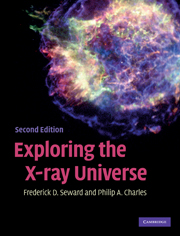Book contents
- Frontmatter
- Contents
- List of acronyms
- Foreword
- Chapter 1 Birth and childhood of X-ray astronomy
- Chapter 2 X-ray emission and interaction with matter
- Chapter 3 Tools and techniques
- Chapter 4 Solar system X-rays
- Chapter 5 X-ray absorption and scattering in the Interstellar Medium
- Chapter 6 Active stellar coronae
- Chapter 7 Early-type stars
- Chapter 8 Supernova explosions and their remnants
- Chapter 9 Neutron stars, pulsars, pulsar wind nebulae, and more supernova remnants
- Chapter 10 Cataclysmic variable stars
- Chapter 11 X-ray binaries
- Chapter 12 Black-hole X-ray binaries
- Chapter 13 Normal and starburst galaxies
- Chapter 14 Active galactic nuclei
- Chapter 15 Clusters of galaxies
- Chapter 16 The diffuse X-ray background
- Chapter 17 Gamma-ray bursts
- Index
- Plate section
Chapter 14 - Active galactic nuclei
Published online by Cambridge University Press: 05 June 2012
- Frontmatter
- Contents
- List of acronyms
- Foreword
- Chapter 1 Birth and childhood of X-ray astronomy
- Chapter 2 X-ray emission and interaction with matter
- Chapter 3 Tools and techniques
- Chapter 4 Solar system X-rays
- Chapter 5 X-ray absorption and scattering in the Interstellar Medium
- Chapter 6 Active stellar coronae
- Chapter 7 Early-type stars
- Chapter 8 Supernova explosions and their remnants
- Chapter 9 Neutron stars, pulsars, pulsar wind nebulae, and more supernova remnants
- Chapter 10 Cataclysmic variable stars
- Chapter 11 X-ray binaries
- Chapter 12 Black-hole X-ray binaries
- Chapter 13 Normal and starburst galaxies
- Chapter 14 Active galactic nuclei
- Chapter 15 Clusters of galaxies
- Chapter 16 The diffuse X-ray background
- Chapter 17 Gamma-ray bursts
- Index
- Plate section
Summary
Introduction
Normal galaxies like our own, when viewed from great distances, appear to be peaceful and unchanging aggregations of stars, whose wellbeing is only slightly disturbed by the occasional supernova explosion. However, violent processes far more powerful than supernovae have been known since early in this century. The optical jet emanating from the giant elliptical galaxy M87 (the dominant galaxy in the relatively nearby Virgo cluster of galaxies) was found in 1917, but its significance was not understood for many years. After the Second World War, the founding of radio astronomy led to the discovery of luminous extragalactic radio sources such as Cygnus A. Also, short-exposure optical photographs showed that some apparently normal spiral galaxies actually had very bright, almost starlike nuclei, the prime example of which is NGC 4151 (Fig. 14.1), hence the term active galactic nuclei, or AGN.
Such galaxies are referred to as Seyfert galaxies, after their discoverer, Carl Seyfert. But even these exotic objects paled in comparison with the enormous energy output at all wavelengths of quasi-stellar objects (better known as quasars, or QSOs), discovered originally through their radio emission in the early 1960s and so-called because of their ‘stellar’ appearance. However, the discovery in 1963 of their very high red-shifts (see Box 14.1) implied that QSOs were immensely distant, and hence they were the most luminous objects in the Universe (see Fig. 14.2).
- Type
- Chapter
- Information
- Exploring the X-ray Universe , pp. 277 - 305Publisher: Cambridge University PressPrint publication year: 2010



